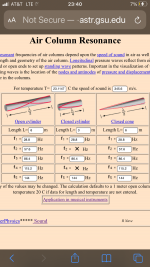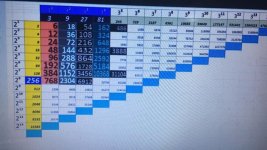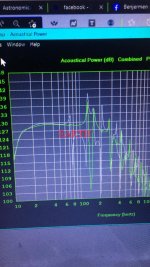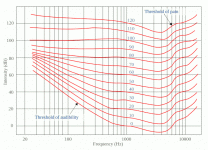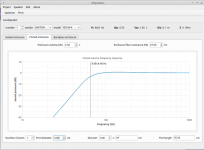There is the XKi speaker (fitted with RS100-4) that works great near-field. It needs damping pads in the front chamber and aperture but has a nice deep response and sounds quite nice. This is the alignment for the 6th order bandpass reflex: 4.0 liter rear chamber and 1.0 liter front chamber with a 0.5in x 5.0in x 9.0in long vent.

I made it in foamcore to test it out:

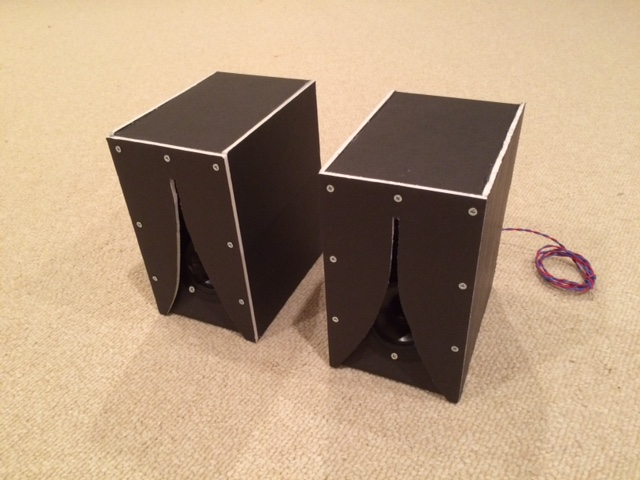

Here are some plans out of wood that a member made:

More info here:
https://www.diyaudio.com/community/threads/xki-xs-ab-initio-karlson-6th-order-bandpass.268524/
I made it in foamcore to test it out:

Here are some plans out of wood that a member made:
More info here:
https://www.diyaudio.com/community/threads/xki-xs-ab-initio-karlson-6th-order-bandpass.268524/
This is great and seems like exactly what I am looking for! Will it be a great improvement over the smaller (but less "compact") 4L BR design?
The advantage is wider dispersion and the aperture acoustically filters some of the mids and highs so that the bass is more well matched. Almost like a baffle step compensation. There are some dips here and there - it’s not a “monitor” but sounds very musical. You might try it in foam core first to see if you like it. Not everyone does - but I think when built of wood, care must be taken to use enough damping pads in the front chamber or it sounds a bit reverberant.
You can use 8ohm on the above design. Should work fine as similar Vas and Qts.
My two cents: a frequency response like the one in Waxx' simulation, which is very flat down to a sharp corner with a very rapid bass fall-off at frequencies below that, invariably has lots of bass "ringing"....design...made by waxx which is great and meets all my requirements but it is too big.
Technically, what's happening is that the Q of the low-pass filter that defines that response is too high, and as a result, it has poor transient response. Whenever a musical note around that frequency comes along, the speaker tends to "boom", with the note continuing to sound long after the signal has passed.
If the music contains lots of energy in that frequency region, the music will sound "boomy" or "muddy".
In my experience, some people aren't bothered by boomy bass with lots of "hangover" (they just want lots of bass). Other people find boomy bass like this very objectionable.
Only you know where your own preferences fall. Maybe boomy bass annoys you a lot. Maybe it doesn't annoy you at all.
Worth noting: there is a direct correlation between frequency response, and transient (time) response. A mathematically perfect flat frequency response from zero frequency to infinite frequency, also has perfect transient response (infinitely fast, and no ringing at all).
Deviations from that perfect flat frequency response, slow down the transient response - it'll be slower, and last longer. The more rapid or extreme the deviation from flat frequency response, the slower the transient response. Abrupt or extreme departures from a flat frequency response cause lots of "hangover", i.e. the speaker continues to make sound after the electrical signal has stopped.
Of course there is no such thing as a real speaker with a perfectly flat response from 0 Hz to infinity, so every real speaker has some "hangover" in its transient response. But when you roll of the bass response very sharply, you create a big, abrupt deviation from a flat response, and the result is poor transient response and lots of ringing around that corner frequency.
The mathematics behind this is the Fourier transform. The frequency response and the transient response (impulse response) are Fourier transforms of each other.
The short and sweet version is this: a more gradual bass rolloff will sound "tighter", "cleaner", or "faster". Trying to extract the lowest possible bass (-3dB) corner frequency from a driver doesn't always produce the best sound.
-Gnobuddy
so many people ‘like’ a less than flat response in areas (but many designers use this as an excuse because their design has obvious issues and so the whole thing is very confusing and there’s no way to decide what you actually like or think that you like without diving into this much deeper, iMhO)My two cents: a frequency response like the one in Waxx' simulation, which is very flat down to a sharp corner with a very rapid bass fall-off at frequencies below that, invariably has lots of bass "ringing".
Technically, what's happening is that the Q of the low-pass filter that defines that response is too high, and as a result, it has poor transient response. Whenever a musical note around that frequency comes along, the speaker tends to "boom", with the note continuing to sound long after the signal has passed.
If the music contains lots of energy in that frequency region, the music will sound "boomy" or "muddy".
In my experience, some people aren't bothered by boomy bass with lots of "hangover" (they just want lots of bass). Other people find boomy bass like this very objectionable.
Only you know where your own preferences fall. Maybe boomy bass annoys you a lot. Maybe it doesn't annoy you at all.
Worth noting: there is a direct correlation between frequency response, and transient (time) response. A mathematically perfect flat frequency response from zero frequency to infinite frequency, also has perfect transient response (infinitely fast, and no ringing at all).
Deviations from that perfect flat frequency response, slow down the transient response - it'll be slower, and last longer. The more rapid or extreme the deviation from flat frequency response, the slower the transient response. Abrupt or extreme departures from a flat frequency response cause lots of "hangover", i.e. the speaker continues to make sound after the electrical signal has stopped.
Of course there is no such thing as a real speaker with a perfectly flat response from 0 Hz to infinity, so every real speaker has some "hangover" in its transient response. But when you roll of the bass response very sharply, you create a big, abrupt deviation from a flat response, and the result is poor transient response and lots of ringing around that corner frequency.
The mathematics behind this is the Fourier transform. The frequency response and the transient response (impulse response) are Fourier transforms of each other.
The short and sweet version is this: a more gradual bass rolloff will sound "tighter", "cleaner", or "faster". Trying to extract the lowest possible bass (-3dB) corner frequency from a driver doesn't always produce the best sound.
-Gnobuddy
I don’t think anyone to argue with your last paragraph though? That however might be More appropriate for the full range TL speaker response? At a certain point somebody has to admit around infrasonic something happens where you might as well just give in to the big fat knee , Because that’s the only way you’re gonna enjoy it(???) feel it, Is buyEnforcing and designing it to be in there so it is very potent
My experience also, AKA the all time (so far) most popular 'West Coast Sound' of Altec, JBL ( Just big & Loud) 😉.
then we would all accidentally have a Paraflex and be disappointed ? (it’s a big smack above 40 and out to 100 or so then after the dip it’s signs off at 150.My experience also, AKA the all time (so far) most popular 'West Coast Sound' of Altec, JBL ( Just big & Loud) 😉.
The nasty phase anomaly that exists at mid 80s causes all kinds of issues that are hard to discern or predict.(
All of these numbers if lined up perfectly would be as seen here where its all exposed ?
Attachments
Last edited:
I agree, confusing, and some of the confusion seems to be deliberate.so many people ‘like’ a less than flat response in areas (but many designers use this as an excuse because their design has obvious issues and so the whole thing is very confusing
I was lucky enough to worke side by side with two very skilled loudspeaker designers for a couple of years, at a company that made pro-audio monitor loudspeakers - the kind used for critical monitoring, mixing, and mastering. Both those engineers had a very, very low opinion of "consumer" speakers.
I didn't understand that at first. Were they just being snooty? Or was their bias justified?
Never having been previously exposed to anything other than consumer speakers, it was a revelation for me when I first heard good quality studio monitors. I was hearing all sorts of things on my old CDs that I had never heard before, even though I had listened to them thousands of times over the years. Wow! Where did all this extra stuff come from, and why had I never heard it before, on all the various speakers I or my friends owned?
At least in the US, most consumer speakers have recessed midrange and boomy bass. Often there is some treble boost built in as well, for that widely heard "boom and tizz" sound.
With consumer-grade speakers, most of the money is spent on appearance, not on sound quality. People will buy good looking boxes with poor-sounding drivers in them, but won't buy ugly boxes with good-sounding drivers in them. Manufacturers know this, so the money gets spent on realistic wood veneers and 3D metallic-looking logos, rather than on quality driver units or good crossover design.
A lot of sonic detail is lost due to the recessed midrange. I don't know why this became a popular choice. It reduces intelligibility of speech and vocals. It makes music sound muffled. I guess it covers up some sins, and that's probably why it became commonly used. But it's the auditory equivalent of looking at the scenery through mist.
I think a good first step to educating one's ears, is to go to a store that sells pro-audio equipment, and see if you can listen to a few different studio monitors. Take along some tracks you're familiar with, so you can see what, if anything, the monitors bring to the party.
I find actually mixing music using a pair of speakers can be very revealing of problems. No wonder studio monitors designed for mixing are held to a higher standard than most consumer-grade speakers.
When it comes to speakers, I think people will argue about anything. 🙂I don’t think anyone to argue with your last paragraph though?
Not sure I follow you here. Transmission lines are supposed to have the best-sounding bass, but in practice I'm not sure they're really different from a well-tuned ported (bass reflex) box.That however might be More appropriate for the full range TL speaker response?
One thing to think about: sealed enclosures have only a 12dB/octave bass rolloff below the corner frequency. Ported boxes fall off at 24 dB/octave - a much steeper departure from "flat". So ported boxes are more prone to "boomy" bass than sealed ones. (But the port can give you so much bass extension that we usually get tempted by it.)
Once you stuff a transmission line enough to stop it being resonant, it seems to give you a 24 dB/octave bass rolloff, too.
While working at that same company, a couple of my officemates designed and built a prototype subwoofer that was showcased at a NAMM show.At a certain point somebody has to admit around infrasonic something happens where you might as well just give in to the big fat knee , Because that’s the only way you’re gonna enjoy it(???) feel it, Is by enforcing and designing it to be in there so it is very potent
I stuck my head in their demo area when I had a free minute, and I thought the bass was horrible. There was lots of it - far too much of it - but it was flabby and "heavy" and continuous. Quite unpleasant, at least to me.
The guys running the booth told me they had set the subwoofer to impress, not to be realistic.
They were right, as there was an overwhelmingly positive reaction from the majority of visitors who stopped by the booth to listen to the subwoofer.
A couple of days after the show was over, a mistake was found in the circuitry of the prototype subwoofer. I've forgotten exactly what caused the problem, but the result was premature clipping of the input stage feeding the subsequent active filters in the subwoofer. At the levels they had turned the sub up to at NAMM, the subwoofer signal had been clipping most of the time!
The high background noise level and steep lowpass filter in the sub electronics hid the harsh clipping, but it translated to endless rumbling deep bass with very little dynamics, which is what I had found so unpleasant.
But most of the prospective buyers who stopped by to listen to it, went away impressed.
So yeah, you're quite right, a lot of people like big, soggy, rumbling deep bass.
-Gnobuddy
Thank you for your very detailed response. This makes a lot of sense. I knew about this "risk" but what I still don't know how much it actually translates to the actual "experience" of the sound.My two cents: a frequency response like the one in Waxx' simulation, which is very flat down to a sharp corner with a very rapid bass fall-off at frequencies below that, invariably has lots of bass "ringing".
Technically, what's happening is that the Q of the low-pass filter that defines that response is too high, and as a result, it has poor transient response. Whenever a musical note around that frequency comes along, the speaker tends to "boom", with the note continuing to sound long after the signal has passed.
If the music contains lots of energy in that frequency region, the music will sound "boomy" or "muddy".
In my experience, some people aren't bothered by boomy bass with lots of "hangover" (they just want lots of bass). Other people find boomy bass like this very objectionable.
Only you know where your own preferences fall. Maybe boomy bass annoys you a lot. Maybe it doesn't annoy you at all.
Worth noting: there is a direct correlation between frequency response, and transient (time) response. A mathematically perfect flat frequency response from zero frequency to infinite frequency, also has perfect transient response (infinitely fast, and no ringing at all).
Deviations from that perfect flat frequency response, slow down the transient response - it'll be slower, and last longer. The more rapid or extreme the deviation from flat frequency response, the slower the transient response. Abrupt or extreme departures from a flat frequency response cause lots of "hangover", i.e. the speaker continues to make sound after the electrical signal has stopped.
Of course there is no such thing as a real speaker with a perfectly flat response from 0 Hz to infinity, so every real speaker has some "hangover" in its transient response. But when you roll of the bass response very sharply, you create a big, abrupt deviation from a flat response, and the result is poor transient response and lots of ringing around that corner frequency.
The mathematics behind this is the Fourier transform. The frequency response and the transient response (impulse response) are Fourier transforms of each other.
The short and sweet version is this: a more gradual bass rolloff will sound "tighter", "cleaner", or "faster". Trying to extract the lowest possible bass (-3dB) corner frequency from a driver doesn't always produce the best sound.
-Gnobuddy
I guess I should try to make a test box and compare it with the Karlsonator that I got suggested.
Eventually, I could change the tuning of the reflex box to match the one of a third order QB3 alignment which should be the "best" sounding one... after all it still requires 4 liters but with a tuning of 64Hz instead of the 55Hz I proposed for the 6th order assisted one.
You're very welcome. I'm glad that was helpful to you. 🙂Thank you for your very detailed response. This makes a lot of sense.
This is where it gets subjective. There is no doubt that boomy bass with lots of "hangover" is unrealistic. But some people like it, unrealistic or not....what I still don't know how much it actually translates to the actual "experience" of the sound.
I have a pair of Alesis M1 Active loudspeakers, and an older pair of Alesis Monitor One MkIIs. I worked with the designers when these speakers went from conception to finished product, so I know a bit about what's inside. (And I've surely forgotten some of it, because this was about 25 years ago.)
Both speakers have the same drivers. The Monitor Ones have a well-designed passive crossover. The M1 Actives have excellent 4th-order active crossovers, with time delay compensation to "line up" the tweeter impulse response with the slower woofer response.
The M1 Actives have the better crossover, no doubt about it. The frequency response is flatter, and stereo imaging is noticeably better, and these speakers reveal even more detail in the music.
IMO, over most of the frequency range, the sound of these M1 Actives compares favourably with a famous Mackie monitor speaker of the same time period. That Mackie sold for about three times the price of the Alesis product.
But the decision was made to push the M1 Active bass response down as low in frequency as possible, probably to compete with the Mackies. There is a bit of bass boost built into the M1 Active electronics to extend the flat region of the response to lower frequencies, and then a very steep bass roll-off below that (4th order active filter, + 4th order acoustic rolloff from the vented cabinet).
The end result was a very flat response down to a very sharp corner (40 Hz, IIRC), with an 8th order roll-off below that.
Speaking only for myself, that decision has ruined the M1 Actives for me. Though the bass response measured flat, it doesn't sound flat - it sounds boomy, flabby, and, to me, disappointingly unpleasant.
So my M1 Actives have been sitting in storage, while the (passive) Monitor Ones continue to be my daily-use speakers.
Speaking only for myself, then, this problem with boomy bass was enough to make those otherwise-better speakers not enjoyable for me.
IMO, this would have been a better product if the bass had been allowed to roll off relatively gently below, say, 60 Hz.
(I have wondered if adding an external gentle high-pass around 60 or 70 Hz might de-boom my M1 Actives, and make them usable again.)
-Gnobuddy
iI (as of the last ~year or so religiously put the mid bass and midrangish driver in a stuffed TL (full range TL often too). maybe it’s how we ‘hear’ ? I had ‘tubes’ in my ears twice as a kid. adenoids and tonsils pulled out? 😨??
Right, we all hear the same, yet not so much! Same here before just shy of age 4 before I can remember. Just realized I've never factored that in WRT why I 'hear' so much differently to the folks that dang near fainted listening to the various esoteric speakers I've had the dubious 'pleasure' of auditioning, especially one that I preconceived would be a treat from a technical POV and turned out to be just a very nice, very expensive sculpture. 🙁
4 liters will always be 4 liters.
since DSP is already in the Recipe.
Simply system would be fullrange speakers on desk
and small simple 8" sub under desk.
80 to 100Hz is likely acceptable for crossover point.
midrange will have clarity, driver not very stressed.
otherwise tall / slim towers with side mount woofer.
peerless and dayton have 8" speakers which work well in
small spaces.
since DSP is already in the Recipe.
Simply system would be fullrange speakers on desk
and small simple 8" sub under desk.
80 to 100Hz is likely acceptable for crossover point.
midrange will have clarity, driver not very stressed.
otherwise tall / slim towers with side mount woofer.
peerless and dayton have 8" speakers which work well in
small spaces.
You know, evolution spent hundreds of millions of years perfecting our hearing - so that we could hear a lion roar in the distance, or the rustle of the dry grass where the tiger was hiding, or the call of a family member across the savannah.Right, we all hear the same, yet not so much!
Our ears are also excellent at all sorts of sophisticated audio signal processing. We can walk into an unfamiliar room blindfolded, speak or clap our hands, listen to the sound, and our ears can give us a pretty good idea if it's a small room or a large room. If our ancestors really did live in caves, it's easy to see how very useful this ability would have been.
But you know what our ears were never designed to do? Listen to music! That was not an evolutionary need. Our ears make terrible measurement microphones, with absolutely horrible frequency response. Just look at the Fletcher-Munson equal loudness contours. They're anything but flat!
Then there's stereo imaging. The illusion of stereo is based on the idea that if the same identical sound is produced by two identical speakers symmetrically placed left and right in front of you, we hear a single sound source in the middle. We're all familiar with that idea.
But can you imagine if our vision worked the same way? If there was a terrifying lioness on our front left, and her twin sister on our front right, can you imagine if our eyes only saw a single lioness in the middle?
How long would our species have lasted, if our vision had been that faulty? If we saw only one lioness where there were actually two? We'd probably run straight into the path of one of the real lionesses, while trying to run away from the non-existent lioness in the middle. Chomp! Snarl! Growl! One more slow, stupid, ground-dwelling ape gone to the great grassland in the sky.
So our hearing is terribly flawed. It's great at the things that kept our ancestors alive on the African savannah 200,000 years ago. But it stinks at critically evaluating music played back on loudspeakers. We even believe there's sound coming from places where there are no speakers at all (stereo imaging).
Music came along long after our ears were done evolving. It was just an accident that long-ago ancestral monkeys on our family tree started hooting and screeching as a way to signal their territory, and as the millions of years rolled by, those hoots and screeches eventually evolved into music, then into speech.
Another 300,000 years go by, and humans invent ways to capture and play back music. And now some of us get very obsessed about how our music sounds. 🙂
-Gnobuddy
Attachments
For fun, I entered the Dayton RS100-4s parameters into Qspeakers, and played with it a little.
Qspeakers thinks a 2.3 litre ported enclosure, with the port tuned to 67 Hz, produces a pretty flat response, with a relatively gentle bass roll-off, and still gets down to 66 Hz (-3 dB).
I like White Dragon's suggestion (post #37). A pair of Dayton RS100-4 in 2.3 litre enclosures with the above tuning could cross over to a sub at 70 Hz or so, which is low enough to have no problems with directionality or "phantom bass" appearing to come from somewhere else.
I know the original intention was to avoid a subwoofer. But 4" speakers are tiny little things. IMO it's hard to get them to go much below 70 Hz with any reasonable sensitivity or SPL capability.
-Gnobuddy
Qspeakers thinks a 2.3 litre ported enclosure, with the port tuned to 67 Hz, produces a pretty flat response, with a relatively gentle bass roll-off, and still gets down to 66 Hz (-3 dB).
I like White Dragon's suggestion (post #37). A pair of Dayton RS100-4 in 2.3 litre enclosures with the above tuning could cross over to a sub at 70 Hz or so, which is low enough to have no problems with directionality or "phantom bass" appearing to come from somewhere else.
I know the original intention was to avoid a subwoofer. But 4" speakers are tiny little things. IMO it's hard to get them to go much below 70 Hz with any reasonable sensitivity or SPL capability.
-Gnobuddy
Attachments
- Home
- Loudspeakers
- Full Range
- Nearfield "truly" fullrange speaker with Dayton RS100-4
